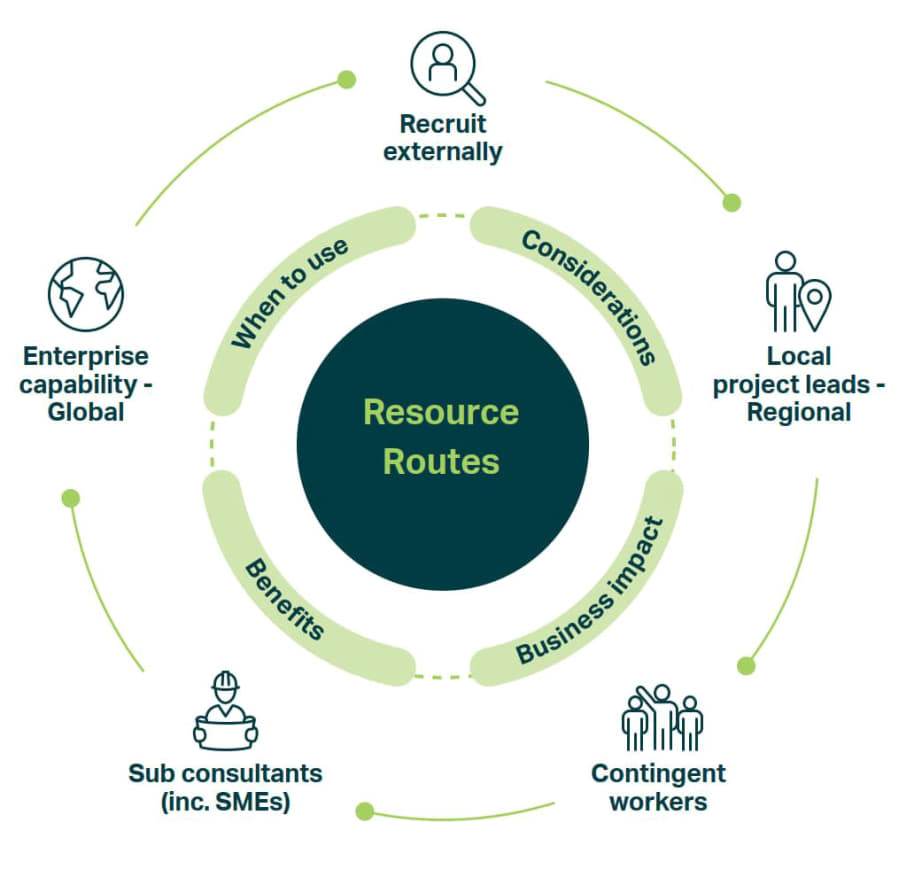An agile staffing model helps us thrive in an ever-changing industry. Here’s how.
In a volatile and unpredictable operating environment, skills shortages are becoming a problem across many industries. Taking a more flexible approach to staffing can mitigate risk, drive profitability and help to build a more stable workforce, writes Trevor Leaker, Head of Architecture and Design within the UK and Ireland at AECOM.
The roll call of “shortage occupations” deemed eligible for skilled worker visas by the UK government is a sobering read for those engaged in major projects in infrastructure development and construction. Among the very long list of professions are civil, mechanical and electrical engineers; design, development, production and process engineers; and architects.
In data published in January 2023, the Office for National Statistics reported that 13.3 per cent of all businesses were experiencing shortages of workers and that there were 48,000 vacancies in construction and 125,000 in professional scientific and technical activities. These statistics merely underline that the ‘war for talent’ rages on.
At AECOM, we are addressing that challenge by developing what we refer to as Resource Routes, which is our answer to building a sustainable resourcing model (see Figure 1.).
This model provides robust and flexible options for staffing projects that ensure we can meet our customers’ needs as we maintain stability and certainty in our own workforce while supplementing it by accessing skills and personnel from different sources across the world.
‘Hire and fire’ is an outdated staffing model
According to traditional resourcing models, locally contracted teams typically focus on recruiting to meet need. But, in an industry characterised by an ebb and flow of work, and of large projects that can be stop-start by nature, this can regularly lead to imbalances in the workforce. The situation is even more complex during periods of volatility such as we are currently experiencing.
A new approach, which leaves behind the ‘hire and fire’ orthodoxy, requires a new mindset that puts sustainable resourcing at the heart of planning right from the outset. So, even as we approach a bid, we ask ourselves what the most effective way to resource a project is, and we factor that into the bid process and our commercial response.
While we are committed to growing and developing our permanent team in a controlled and sustainable fashion, we also build capacity from other sources when we ramp up a new project. This can include colleagues from other AECOM offices; our specialist technical delivery teams based around the globe; small and medium-sized businesses (SMEs) local or specific to the project; partner practices; and self-employed contractors.

A commitment to small and medium-sized businesses (SMEs)
In the UK, our design of a major maternity and children’s facility at the Royal Victoria Hospital in Belfast showcases AECOM’s willingness and commitment to work with SMEs, where a constructive, ten-year partnership with local firm Isherwood + Ellis has seen it deliver nearly half of the architectural scope.
Our aim is to build long-term mutually beneficial partnerships, as is the case when we engage with sub-contractor partners on projects.
Working closely with SMEs not only helps us to contract local expertise but is also an element of our commitment to the ESG principle of bringing additional benefits to those communities in which we operate. The SMEs with which we work have a platform and resources to access opportunities they might otherwise miss, and this helps to bring investment to local economies.
According to our current estimates, over 40 per cent of our subconsultant spending in the last financial year was with SMEs.
Thinking and acting globally
As a global organisation, AECOM can draw support from other geographies. In our UK and Ireland business, for example, we regularly work very closely with colleagues from our office in Madrid, a centre of excellence (CoE) specialising in architecture and design. It’s also not unusual for projects to draw on expertise from many different places.
One such example is a Europe-wide project to build a scientific campus for a pharmaceutical company in Belgium. This project engages colleagues from across our network of UK and continental Europe offices, technical delivery centres in Asia, and a local SME practice – to ensure local code compliance and have ‘boots on the ground’.
An additional advantage of the global technical delivery teams is that they can provide round-the-clock support.
Collaboration enhanced by technology
Even before the coronavirus pandemic made the provision of flexible and hybrid working an imperative, AECOM was adopting a more agile approach to the staffing of projects, supported by advances in communications technology.
From a delivery perspective, tapping into expertise in different geographies gives us the ability to manage peaks and troughs more effectively. From a career development perspective, we know that our people value the opportunity to gain experience by working on a range of local and international projects.
Agile staffing strategies are sustainable and beneficial
Delivering major infrastructure projects on time and on budget is a significant challenge in an unpredictable and volatile operating environment. It’s a challenge that impacts clients as well as their design and construction teams so deploying the right people in a timely manner is a way to address that key piece of the puzzle.
By developing agile staffing strategies that take a sustainable approach to resourcing, organisations can be more efficient and profitable, ensure project-specific knowledge is retained through its duration, and help to free the permanent workforce from uncertain demand. We’ve seen the benefits of it in our organisation and hope to see it emerge throughout our industry.
Want to learn more?
For more insights into how the industry can encourage, upskill and attract a workforce fit for the challenges and opportunities that lie ahead, tune into our Talking Infrastructure podcast episode: Engineer of the future: building tomorrow’s workforce.
A version of this article was published in Architects Journal.






